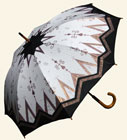When fabric painting, you often need the fabric to be stretched or pinned onto a frame. When painting on a parasol, the fabric is already wonderfully stretched for you. Whether it is used to keep the sun of at the beach or as a decorative element in your house, you'll find these cotton umbrellas from Jacquard are fun to paint and addictive. Once you've painted one you'll find yourself hooked!
 |
 |
 |
|
artist: Sheila Haynes Rauen |
artist: Sue Stover |
artist: Kim Meyer |
- Materials:
- Textile Colors
- Lumiere & Neopaque
- Dye-Na-Flow
- Cotton Umbrella
- Applicator Bottle with #7 Metal Tip
- Brushes
- Auto Fade Pen: Use to draw temporary lines that automatically disappear when you're done.
- Masking Tape
Procedure:
| 1. Choose a light colored or white parasol that is free of sizing. Paints always adhere best to clean fibers. |
| 2. Decide which paint colors to use on your parasol. You can use as few or as many colors as you like. Textile Colors, Lumiere, and Neopaque are light bodied acrylic fabric paints and can be applied with a slightly stiff inexpensive brush and cleaned up with water. Dye-Na-Flow is also an acrylic fabric paint but it has a thinner base so it flows on the fabric and produces more of a watercolor effect. |
| 3. It can be helpful to draw out your design with an auto fade pen before starting to paint. The pen lines disappear when touched by water or paint. This can help you position your design and give you more confidence to apply the paint. |
| 4. Masking tape in different widths can be applied to do an abstract design. A simple row of tape can suggest a fence in a garden scene. Apply the tape before painting and leave in position until the painted parasol is completely dry. Peel off the tape to reveal the white cotton fabric masked below. Make sure the tape is pressed down firmly onto the fabric so that you get a clean mask. Some white can really add a little zing to your whole design. |
| 5. Both Jacquard Textile Colors and Jacquard Lumiere are heat fix paints. When the paint is completely dry, iron for two to three minutes. Use the dry cotton setting and keep the iron moving at all times. In the difficult to iron areas you can use a hair dryer and heat for two to three minutes on hot. If the parasol is for decorative use only, no need to heat fix. Promptly clean all tools with warm water. |
Tips & Suggestions:
- Add dots or swirls to your design by using some paint in an applicator bottle.
- Try stamping a design with big foam stamps that are found in most craft stores. Use a stamp with a large open design to get a good impression.
- Be careful using the auto fade pen in a humid region. If your drawn design is left overnight, it may not be there in the morning!
- After fixing the paints, spray on some Scotchguard to help make the parasol mist-proof.












